Sainsbury's: Strategic Management and Competitive Analysis Report
VerifiedAdded on 2023/01/11
|12
|3651
|36
Report
AI Summary
This report provides a comprehensive strategic management analysis of Sainsbury's, a prominent multinational supermarket chain in the United Kingdom. The report begins with an introduction to strategic management and its importance in adapting to the changing business environment. The main body of the report compares strategic theory and practices using Porter's Five Forces model to analyze Sainsbury's competitive position. The analysis covers the threat of new entrants, the bargaining power of suppliers and customers, the threat of substitute products, and competitive rivalry within the retail industry. The report examines Sainsbury's vision, mission, and strategic objectives, including its cost leadership strategy and online retailing initiatives. The report concludes with a summary of findings and references used in the analysis. This report highlights Sainsbury's strategies to maintain its market position and address competitive challenges.
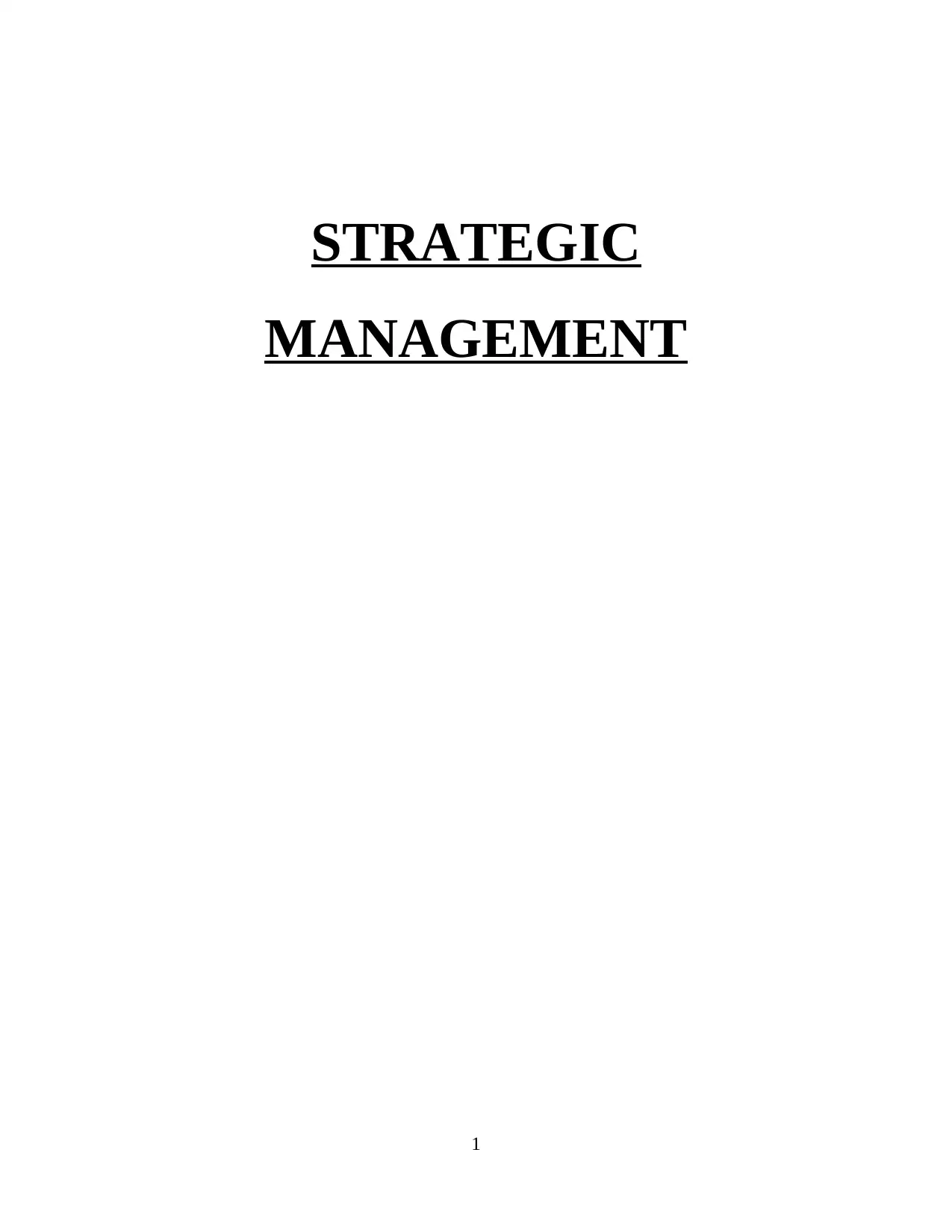
STRATEGIC
MANAGEMENT
1
MANAGEMENT
1
Paraphrase This Document
Need a fresh take? Get an instant paraphrase of this document with our AI Paraphraser
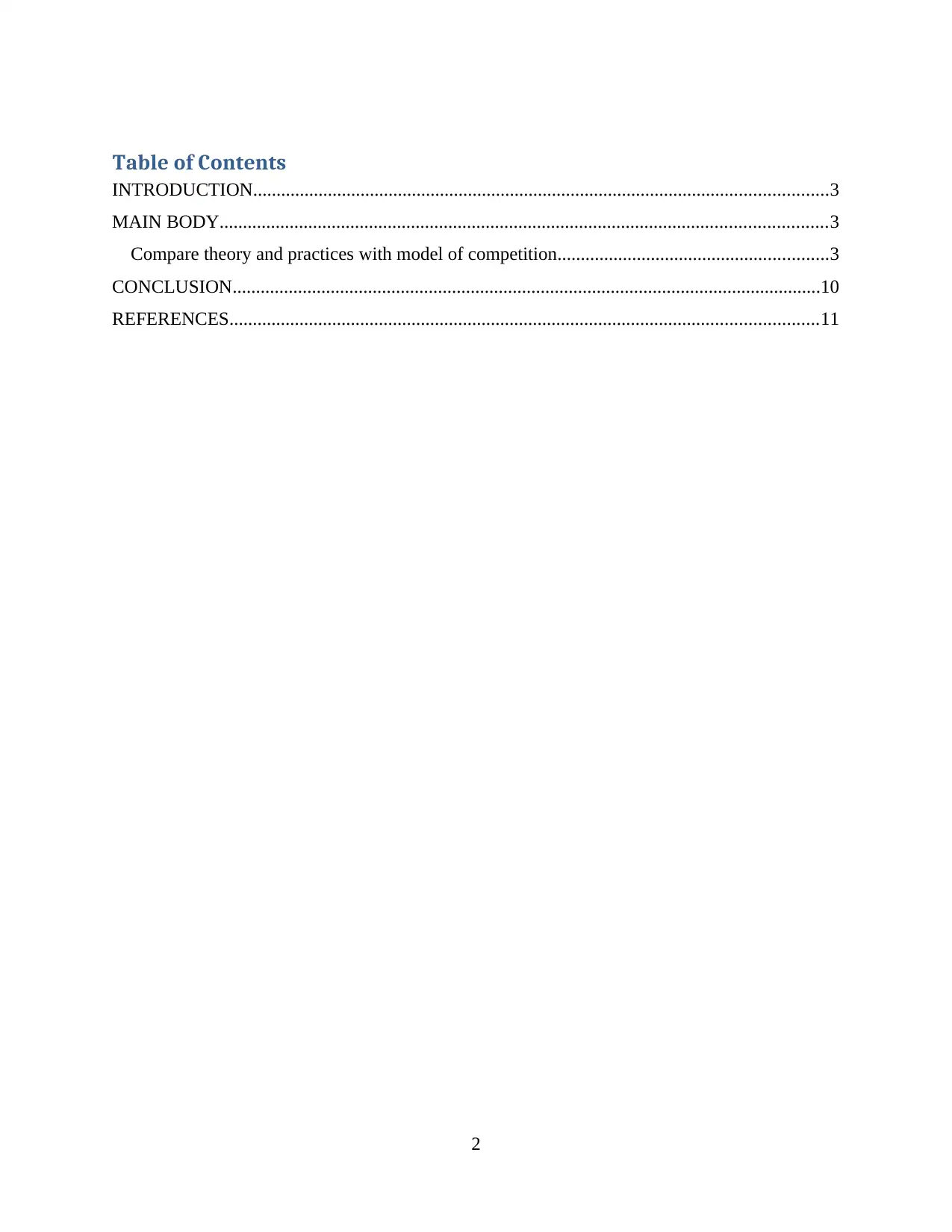
Table of Contents
INTRODUCTION...........................................................................................................................3
MAIN BODY..................................................................................................................................3
Compare theory and practices with model of competition..........................................................3
CONCLUSION..............................................................................................................................10
REFERENCES..............................................................................................................................11
2
INTRODUCTION...........................................................................................................................3
MAIN BODY..................................................................................................................................3
Compare theory and practices with model of competition..........................................................3
CONCLUSION..............................................................................................................................10
REFERENCES..............................................................................................................................11
2
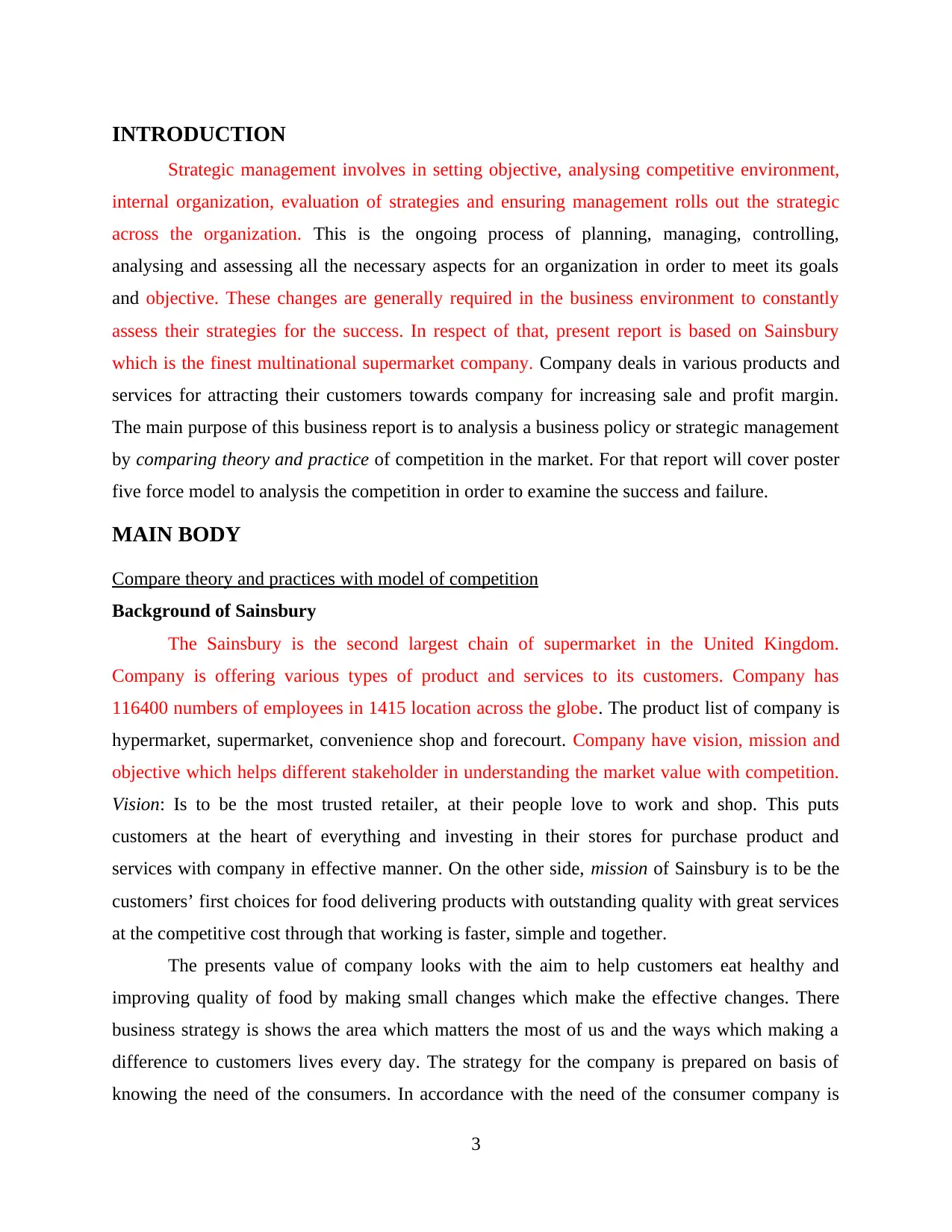
INTRODUCTION
Strategic management involves in setting objective, analysing competitive environment,
internal organization, evaluation of strategies and ensuring management rolls out the strategic
across the organization. This is the ongoing process of planning, managing, controlling,
analysing and assessing all the necessary aspects for an organization in order to meet its goals
and objective. These changes are generally required in the business environment to constantly
assess their strategies for the success. In respect of that, present report is based on Sainsbury
which is the finest multinational supermarket company. Company deals in various products and
services for attracting their customers towards company for increasing sale and profit margin.
The main purpose of this business report is to analysis a business policy or strategic management
by comparing theory and practice of competition in the market. For that report will cover poster
five force model to analysis the competition in order to examine the success and failure.
MAIN BODY
Compare theory and practices with model of competition
Background of Sainsbury
The Sainsbury is the second largest chain of supermarket in the United Kingdom.
Company is offering various types of product and services to its customers. Company has
116400 numbers of employees in 1415 location across the globe. The product list of company is
hypermarket, supermarket, convenience shop and forecourt. Company have vision, mission and
objective which helps different stakeholder in understanding the market value with competition.
Vision: Is to be the most trusted retailer, at their people love to work and shop. This puts
customers at the heart of everything and investing in their stores for purchase product and
services with company in effective manner. On the other side, mission of Sainsbury is to be the
customers’ first choices for food delivering products with outstanding quality with great services
at the competitive cost through that working is faster, simple and together.
The presents value of company looks with the aim to help customers eat healthy and
improving quality of food by making small changes which make the effective changes. There
business strategy is shows the area which matters the most of us and the ways which making a
difference to customers lives every day. The strategy for the company is prepared on basis of
knowing the need of the consumers. In accordance with the need of the consumer company is
3
Strategic management involves in setting objective, analysing competitive environment,
internal organization, evaluation of strategies and ensuring management rolls out the strategic
across the organization. This is the ongoing process of planning, managing, controlling,
analysing and assessing all the necessary aspects for an organization in order to meet its goals
and objective. These changes are generally required in the business environment to constantly
assess their strategies for the success. In respect of that, present report is based on Sainsbury
which is the finest multinational supermarket company. Company deals in various products and
services for attracting their customers towards company for increasing sale and profit margin.
The main purpose of this business report is to analysis a business policy or strategic management
by comparing theory and practice of competition in the market. For that report will cover poster
five force model to analysis the competition in order to examine the success and failure.
MAIN BODY
Compare theory and practices with model of competition
Background of Sainsbury
The Sainsbury is the second largest chain of supermarket in the United Kingdom.
Company is offering various types of product and services to its customers. Company has
116400 numbers of employees in 1415 location across the globe. The product list of company is
hypermarket, supermarket, convenience shop and forecourt. Company have vision, mission and
objective which helps different stakeholder in understanding the market value with competition.
Vision: Is to be the most trusted retailer, at their people love to work and shop. This puts
customers at the heart of everything and investing in their stores for purchase product and
services with company in effective manner. On the other side, mission of Sainsbury is to be the
customers’ first choices for food delivering products with outstanding quality with great services
at the competitive cost through that working is faster, simple and together.
The presents value of company looks with the aim to help customers eat healthy and
improving quality of food by making small changes which make the effective changes. There
business strategy is shows the area which matters the most of us and the ways which making a
difference to customers lives every day. The strategy for the company is prepared on basis of
knowing the need of the consumers. In accordance with the need of the consumer company is
3
⊘ This is a preview!⊘
Do you want full access?
Subscribe today to unlock all pages.

Trusted by 1+ million students worldwide
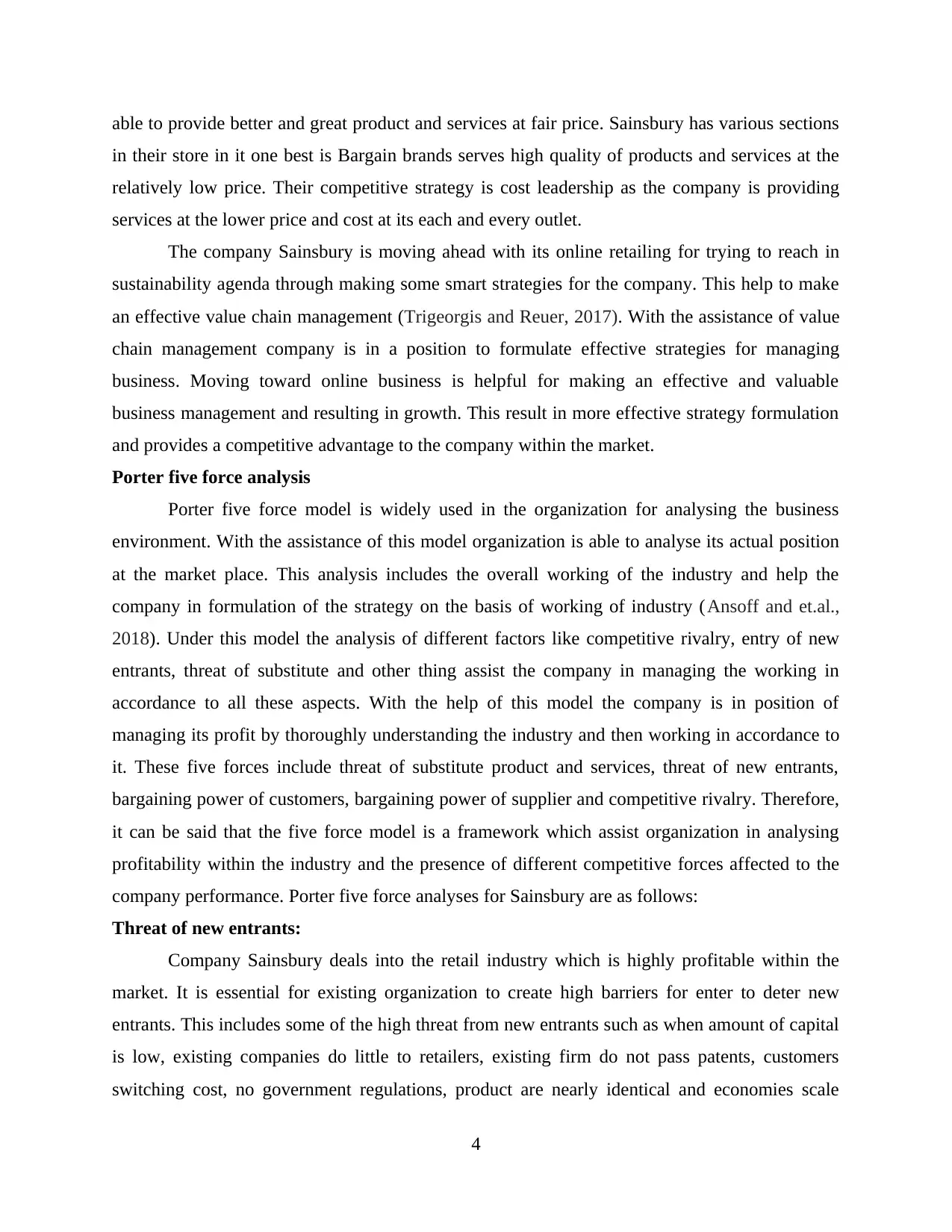
able to provide better and great product and services at fair price. Sainsbury has various sections
in their store in it one best is Bargain brands serves high quality of products and services at the
relatively low price. Their competitive strategy is cost leadership as the company is providing
services at the lower price and cost at its each and every outlet.
The company Sainsbury is moving ahead with its online retailing for trying to reach in
sustainability agenda through making some smart strategies for the company. This help to make
an effective value chain management (Trigeorgis and Reuer, 2017). With the assistance of value
chain management company is in a position to formulate effective strategies for managing
business. Moving toward online business is helpful for making an effective and valuable
business management and resulting in growth. This result in more effective strategy formulation
and provides a competitive advantage to the company within the market.
Porter five force analysis
Porter five force model is widely used in the organization for analysing the business
environment. With the assistance of this model organization is able to analyse its actual position
at the market place. This analysis includes the overall working of the industry and help the
company in formulation of the strategy on the basis of working of industry (Ansoff and et.al.,
2018). Under this model the analysis of different factors like competitive rivalry, entry of new
entrants, threat of substitute and other thing assist the company in managing the working in
accordance to all these aspects. With the help of this model the company is in position of
managing its profit by thoroughly understanding the industry and then working in accordance to
it. These five forces include threat of substitute product and services, threat of new entrants,
bargaining power of customers, bargaining power of supplier and competitive rivalry. Therefore,
it can be said that the five force model is a framework which assist organization in analysing
profitability within the industry and the presence of different competitive forces affected to the
company performance. Porter five force analyses for Sainsbury are as follows:
Threat of new entrants:
Company Sainsbury deals into the retail industry which is highly profitable within the
market. It is essential for existing organization to create high barriers for enter to deter new
entrants. This includes some of the high threat from new entrants such as when amount of capital
is low, existing companies do little to retailers, existing firm do not pass patents, customers
switching cost, no government regulations, product are nearly identical and economies scale
4
in their store in it one best is Bargain brands serves high quality of products and services at the
relatively low price. Their competitive strategy is cost leadership as the company is providing
services at the lower price and cost at its each and every outlet.
The company Sainsbury is moving ahead with its online retailing for trying to reach in
sustainability agenda through making some smart strategies for the company. This help to make
an effective value chain management (Trigeorgis and Reuer, 2017). With the assistance of value
chain management company is in a position to formulate effective strategies for managing
business. Moving toward online business is helpful for making an effective and valuable
business management and resulting in growth. This result in more effective strategy formulation
and provides a competitive advantage to the company within the market.
Porter five force analysis
Porter five force model is widely used in the organization for analysing the business
environment. With the assistance of this model organization is able to analyse its actual position
at the market place. This analysis includes the overall working of the industry and help the
company in formulation of the strategy on the basis of working of industry (Ansoff and et.al.,
2018). Under this model the analysis of different factors like competitive rivalry, entry of new
entrants, threat of substitute and other thing assist the company in managing the working in
accordance to all these aspects. With the help of this model the company is in position of
managing its profit by thoroughly understanding the industry and then working in accordance to
it. These five forces include threat of substitute product and services, threat of new entrants,
bargaining power of customers, bargaining power of supplier and competitive rivalry. Therefore,
it can be said that the five force model is a framework which assist organization in analysing
profitability within the industry and the presence of different competitive forces affected to the
company performance. Porter five force analyses for Sainsbury are as follows:
Threat of new entrants:
Company Sainsbury deals into the retail industry which is highly profitable within the
market. It is essential for existing organization to create high barriers for enter to deter new
entrants. This includes some of the high threat from new entrants such as when amount of capital
is low, existing companies do little to retailers, existing firm do not pass patents, customers
switching cost, no government regulations, product are nearly identical and economies scale
4
Paraphrase This Document
Need a fresh take? Get an instant paraphrase of this document with our AI Paraphraser
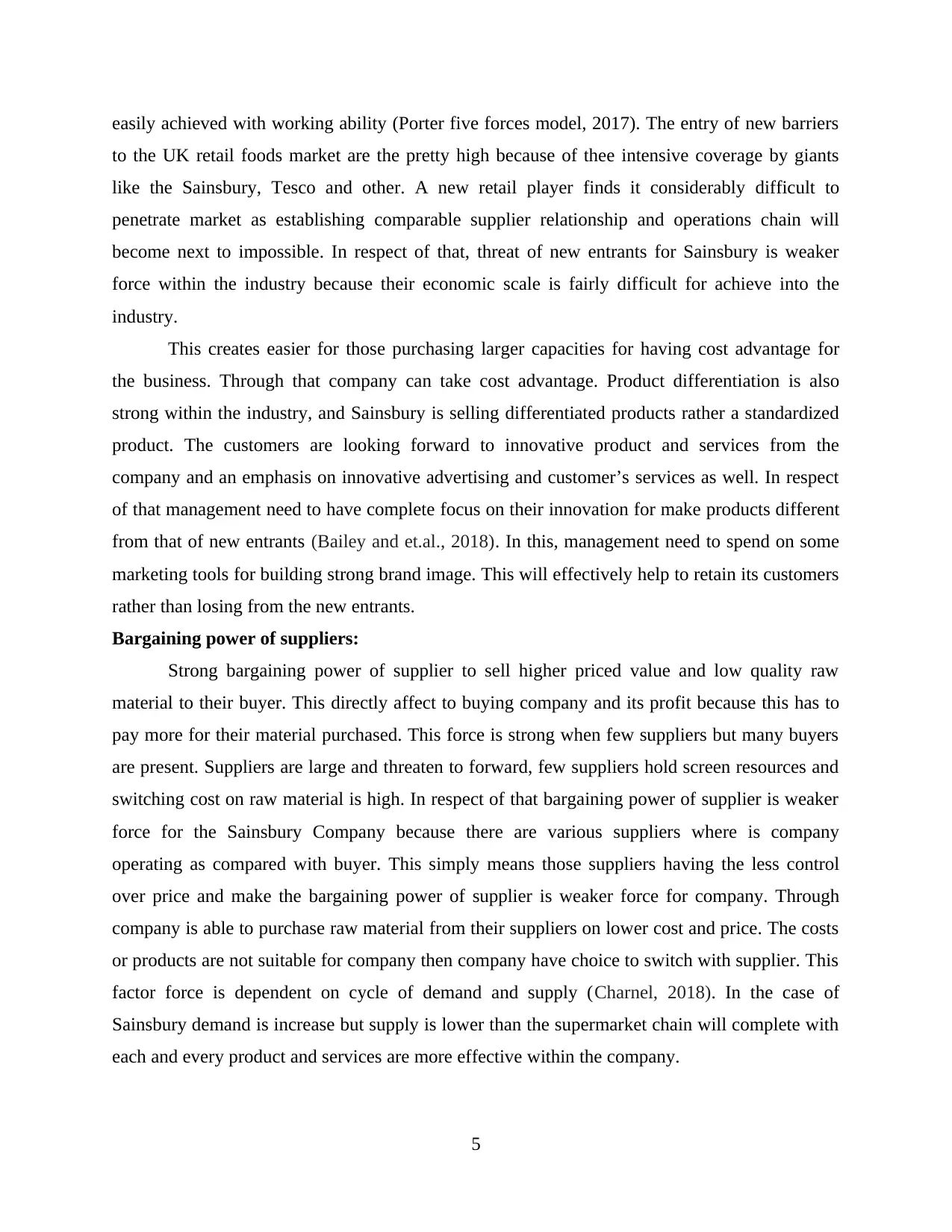
easily achieved with working ability (Porter five forces model, 2017). The entry of new barriers
to the UK retail foods market are the pretty high because of thee intensive coverage by giants
like the Sainsbury, Tesco and other. A new retail player finds it considerably difficult to
penetrate market as establishing comparable supplier relationship and operations chain will
become next to impossible. In respect of that, threat of new entrants for Sainsbury is weaker
force within the industry because their economic scale is fairly difficult for achieve into the
industry.
This creates easier for those purchasing larger capacities for having cost advantage for
the business. Through that company can take cost advantage. Product differentiation is also
strong within the industry, and Sainsbury is selling differentiated products rather a standardized
product. The customers are looking forward to innovative product and services from the
company and an emphasis on innovative advertising and customer’s services as well. In respect
of that management need to have complete focus on their innovation for make products different
from that of new entrants (Bailey and et.al., 2018). In this, management need to spend on some
marketing tools for building strong brand image. This will effectively help to retain its customers
rather than losing from the new entrants.
Bargaining power of suppliers:
Strong bargaining power of supplier to sell higher priced value and low quality raw
material to their buyer. This directly affect to buying company and its profit because this has to
pay more for their material purchased. This force is strong when few suppliers but many buyers
are present. Suppliers are large and threaten to forward, few suppliers hold screen resources and
switching cost on raw material is high. In respect of that bargaining power of supplier is weaker
force for the Sainsbury Company because there are various suppliers where is company
operating as compared with buyer. This simply means those suppliers having the less control
over price and make the bargaining power of supplier is weaker force for company. Through
company is able to purchase raw material from their suppliers on lower cost and price. The costs
or products are not suitable for company then company have choice to switch with supplier. This
factor force is dependent on cycle of demand and supply (Charnel, 2018). In the case of
Sainsbury demand is increase but supply is lower than the supermarket chain will complete with
each and every product and services are more effective within the company.
5
to the UK retail foods market are the pretty high because of thee intensive coverage by giants
like the Sainsbury, Tesco and other. A new retail player finds it considerably difficult to
penetrate market as establishing comparable supplier relationship and operations chain will
become next to impossible. In respect of that, threat of new entrants for Sainsbury is weaker
force within the industry because their economic scale is fairly difficult for achieve into the
industry.
This creates easier for those purchasing larger capacities for having cost advantage for
the business. Through that company can take cost advantage. Product differentiation is also
strong within the industry, and Sainsbury is selling differentiated products rather a standardized
product. The customers are looking forward to innovative product and services from the
company and an emphasis on innovative advertising and customer’s services as well. In respect
of that management need to have complete focus on their innovation for make products different
from that of new entrants (Bailey and et.al., 2018). In this, management need to spend on some
marketing tools for building strong brand image. This will effectively help to retain its customers
rather than losing from the new entrants.
Bargaining power of suppliers:
Strong bargaining power of supplier to sell higher priced value and low quality raw
material to their buyer. This directly affect to buying company and its profit because this has to
pay more for their material purchased. This force is strong when few suppliers but many buyers
are present. Suppliers are large and threaten to forward, few suppliers hold screen resources and
switching cost on raw material is high. In respect of that bargaining power of supplier is weaker
force for the Sainsbury Company because there are various suppliers where is company
operating as compared with buyer. This simply means those suppliers having the less control
over price and make the bargaining power of supplier is weaker force for company. Through
company is able to purchase raw material from their suppliers on lower cost and price. The costs
or products are not suitable for company then company have choice to switch with supplier. This
factor force is dependent on cycle of demand and supply (Charnel, 2018). In the case of
Sainsbury demand is increase but supply is lower than the supermarket chain will complete with
each and every product and services are more effective within the company.
5
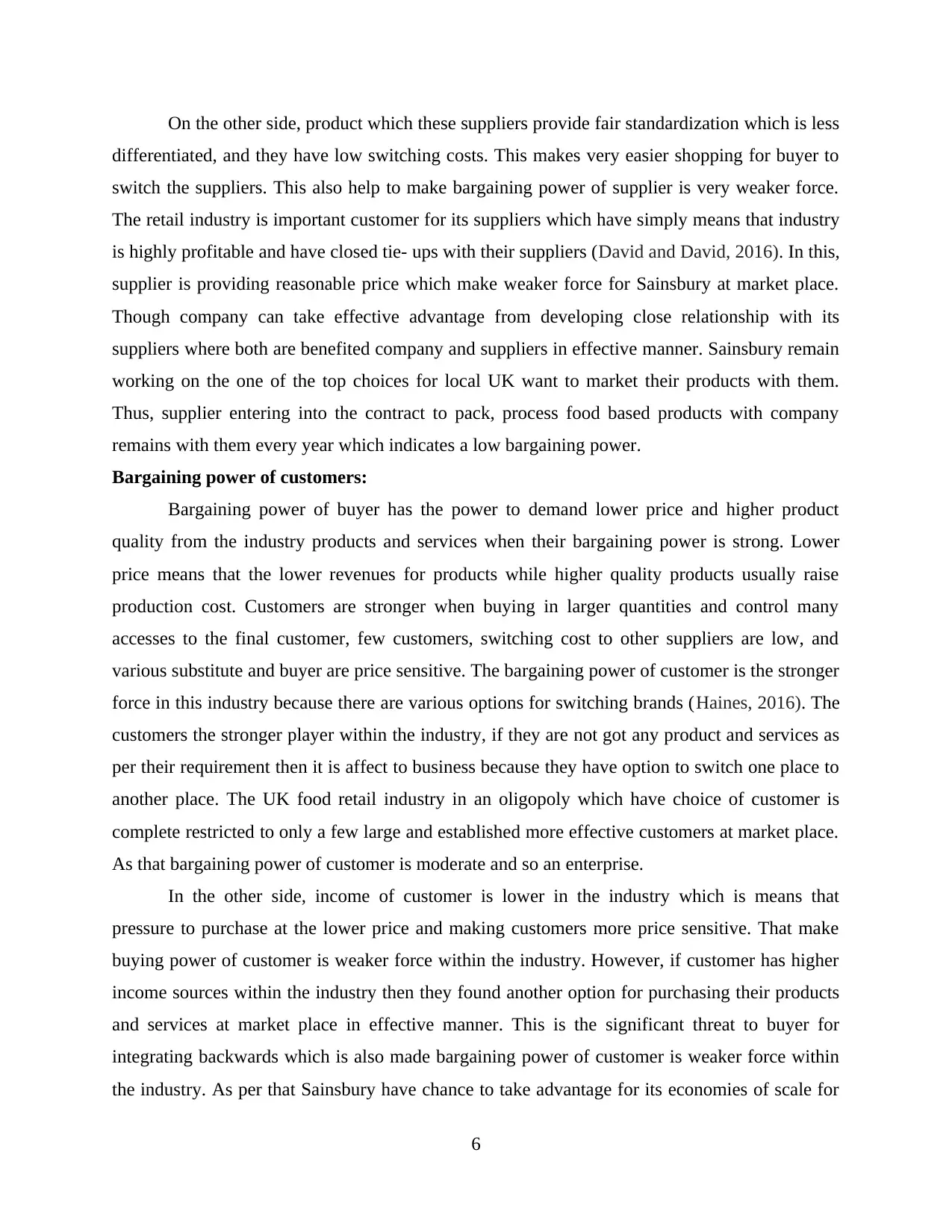
On the other side, product which these suppliers provide fair standardization which is less
differentiated, and they have low switching costs. This makes very easier shopping for buyer to
switch the suppliers. This also help to make bargaining power of supplier is very weaker force.
The retail industry is important customer for its suppliers which have simply means that industry
is highly profitable and have closed tie- ups with their suppliers (David and David, 2016). In this,
supplier is providing reasonable price which make weaker force for Sainsbury at market place.
Though company can take effective advantage from developing close relationship with its
suppliers where both are benefited company and suppliers in effective manner. Sainsbury remain
working on the one of the top choices for local UK want to market their products with them.
Thus, supplier entering into the contract to pack, process food based products with company
remains with them every year which indicates a low bargaining power.
Bargaining power of customers:
Bargaining power of buyer has the power to demand lower price and higher product
quality from the industry products and services when their bargaining power is strong. Lower
price means that the lower revenues for products while higher quality products usually raise
production cost. Customers are stronger when buying in larger quantities and control many
accesses to the final customer, few customers, switching cost to other suppliers are low, and
various substitute and buyer are price sensitive. The bargaining power of customer is the stronger
force in this industry because there are various options for switching brands (Haines, 2016). The
customers the stronger player within the industry, if they are not got any product and services as
per their requirement then it is affect to business because they have option to switch one place to
another place. The UK food retail industry in an oligopoly which have choice of customer is
complete restricted to only a few large and established more effective customers at market place.
As that bargaining power of customer is moderate and so an enterprise.
In the other side, income of customer is lower in the industry which is means that
pressure to purchase at the lower price and making customers more price sensitive. That make
buying power of customer is weaker force within the industry. However, if customer has higher
income sources within the industry then they found another option for purchasing their products
and services at market place in effective manner. This is the significant threat to buyer for
integrating backwards which is also made bargaining power of customer is weaker force within
the industry. As per that Sainsbury have chance to take advantage for its economies of scale for
6
differentiated, and they have low switching costs. This makes very easier shopping for buyer to
switch the suppliers. This also help to make bargaining power of supplier is very weaker force.
The retail industry is important customer for its suppliers which have simply means that industry
is highly profitable and have closed tie- ups with their suppliers (David and David, 2016). In this,
supplier is providing reasonable price which make weaker force for Sainsbury at market place.
Though company can take effective advantage from developing close relationship with its
suppliers where both are benefited company and suppliers in effective manner. Sainsbury remain
working on the one of the top choices for local UK want to market their products with them.
Thus, supplier entering into the contract to pack, process food based products with company
remains with them every year which indicates a low bargaining power.
Bargaining power of customers:
Bargaining power of buyer has the power to demand lower price and higher product
quality from the industry products and services when their bargaining power is strong. Lower
price means that the lower revenues for products while higher quality products usually raise
production cost. Customers are stronger when buying in larger quantities and control many
accesses to the final customer, few customers, switching cost to other suppliers are low, and
various substitute and buyer are price sensitive. The bargaining power of customer is the stronger
force in this industry because there are various options for switching brands (Haines, 2016). The
customers the stronger player within the industry, if they are not got any product and services as
per their requirement then it is affect to business because they have option to switch one place to
another place. The UK food retail industry in an oligopoly which have choice of customer is
complete restricted to only a few large and established more effective customers at market place.
As that bargaining power of customer is moderate and so an enterprise.
In the other side, income of customer is lower in the industry which is means that
pressure to purchase at the lower price and making customers more price sensitive. That make
buying power of customer is weaker force within the industry. However, if customer has higher
income sources within the industry then they found another option for purchasing their products
and services at market place in effective manner. This is the significant threat to buyer for
integrating backwards which is also made bargaining power of customer is weaker force within
the industry. As per that Sainsbury have chance to take advantage for its economies of scale for
6
⊘ This is a preview!⊘
Do you want full access?
Subscribe today to unlock all pages.

Trusted by 1+ million students worldwide
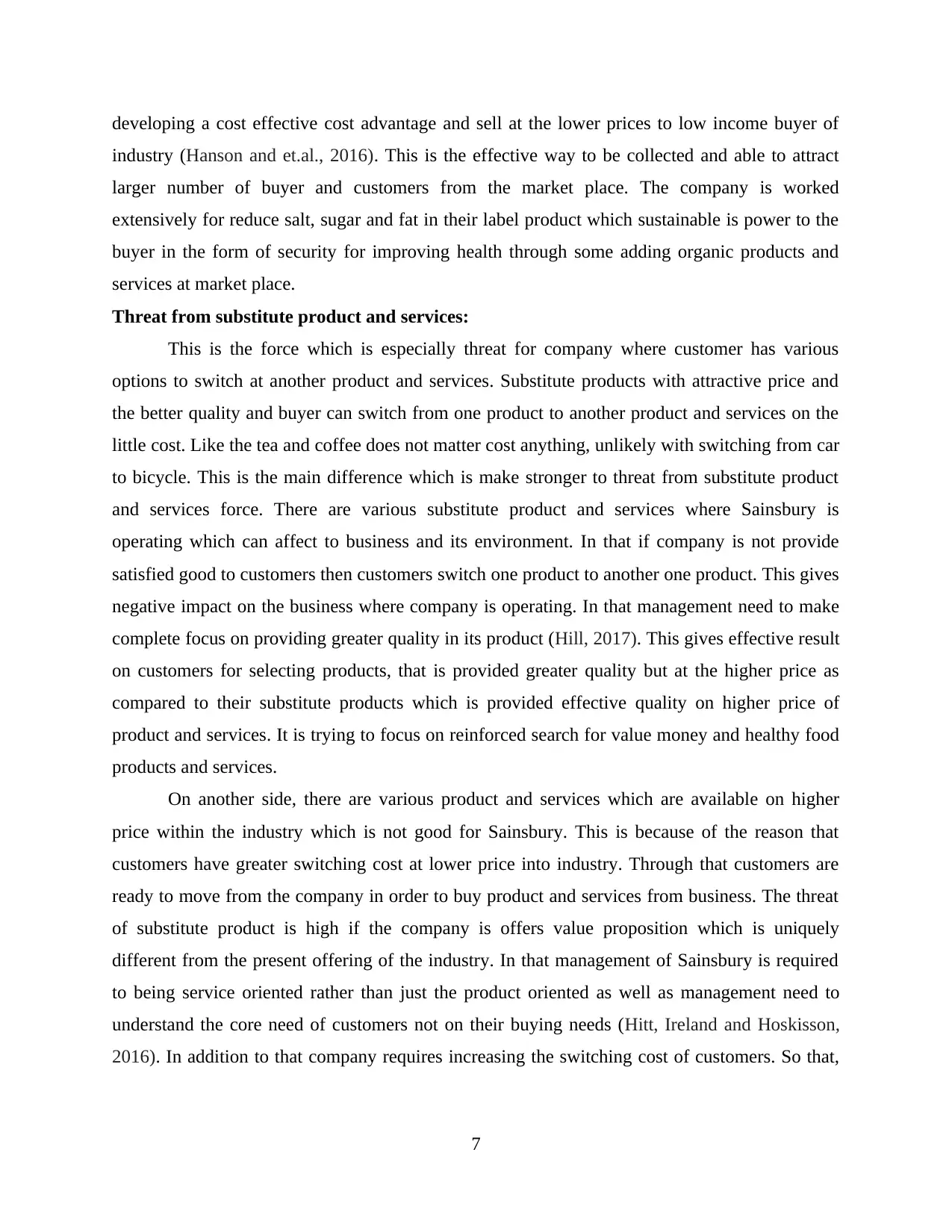
developing a cost effective cost advantage and sell at the lower prices to low income buyer of
industry (Hanson and et.al., 2016). This is the effective way to be collected and able to attract
larger number of buyer and customers from the market place. The company is worked
extensively for reduce salt, sugar and fat in their label product which sustainable is power to the
buyer in the form of security for improving health through some adding organic products and
services at market place.
Threat from substitute product and services:
This is the force which is especially threat for company where customer has various
options to switch at another product and services. Substitute products with attractive price and
the better quality and buyer can switch from one product to another product and services on the
little cost. Like the tea and coffee does not matter cost anything, unlikely with switching from car
to bicycle. This is the main difference which is make stronger to threat from substitute product
and services force. There are various substitute product and services where Sainsbury is
operating which can affect to business and its environment. In that if company is not provide
satisfied good to customers then customers switch one product to another one product. This gives
negative impact on the business where company is operating. In that management need to make
complete focus on providing greater quality in its product (Hill, 2017). This gives effective result
on customers for selecting products, that is provided greater quality but at the higher price as
compared to their substitute products which is provided effective quality on higher price of
product and services. It is trying to focus on reinforced search for value money and healthy food
products and services.
On another side, there are various product and services which are available on higher
price within the industry which is not good for Sainsbury. This is because of the reason that
customers have greater switching cost at lower price into industry. Through that customers are
ready to move from the company in order to buy product and services from business. The threat
of substitute product is high if the company is offers value proposition which is uniquely
different from the present offering of the industry. In that management of Sainsbury is required
to being service oriented rather than just the product oriented as well as management need to
understand the core need of customers not on their buying needs (Hitt, Ireland and Hoskisson,
2016). In addition to that company requires increasing the switching cost of customers. So that,
7
industry (Hanson and et.al., 2016). This is the effective way to be collected and able to attract
larger number of buyer and customers from the market place. The company is worked
extensively for reduce salt, sugar and fat in their label product which sustainable is power to the
buyer in the form of security for improving health through some adding organic products and
services at market place.
Threat from substitute product and services:
This is the force which is especially threat for company where customer has various
options to switch at another product and services. Substitute products with attractive price and
the better quality and buyer can switch from one product to another product and services on the
little cost. Like the tea and coffee does not matter cost anything, unlikely with switching from car
to bicycle. This is the main difference which is make stronger to threat from substitute product
and services force. There are various substitute product and services where Sainsbury is
operating which can affect to business and its environment. In that if company is not provide
satisfied good to customers then customers switch one product to another one product. This gives
negative impact on the business where company is operating. In that management need to make
complete focus on providing greater quality in its product (Hill, 2017). This gives effective result
on customers for selecting products, that is provided greater quality but at the higher price as
compared to their substitute products which is provided effective quality on higher price of
product and services. It is trying to focus on reinforced search for value money and healthy food
products and services.
On another side, there are various product and services which are available on higher
price within the industry which is not good for Sainsbury. This is because of the reason that
customers have greater switching cost at lower price into industry. Through that customers are
ready to move from the company in order to buy product and services from business. The threat
of substitute product is high if the company is offers value proposition which is uniquely
different from the present offering of the industry. In that management of Sainsbury is required
to being service oriented rather than just the product oriented as well as management need to
understand the core need of customers not on their buying needs (Hitt, Ireland and Hoskisson,
2016). In addition to that company requires increasing the switching cost of customers. So that,
7
Paraphrase This Document
Need a fresh take? Get an instant paraphrase of this document with our AI Paraphraser
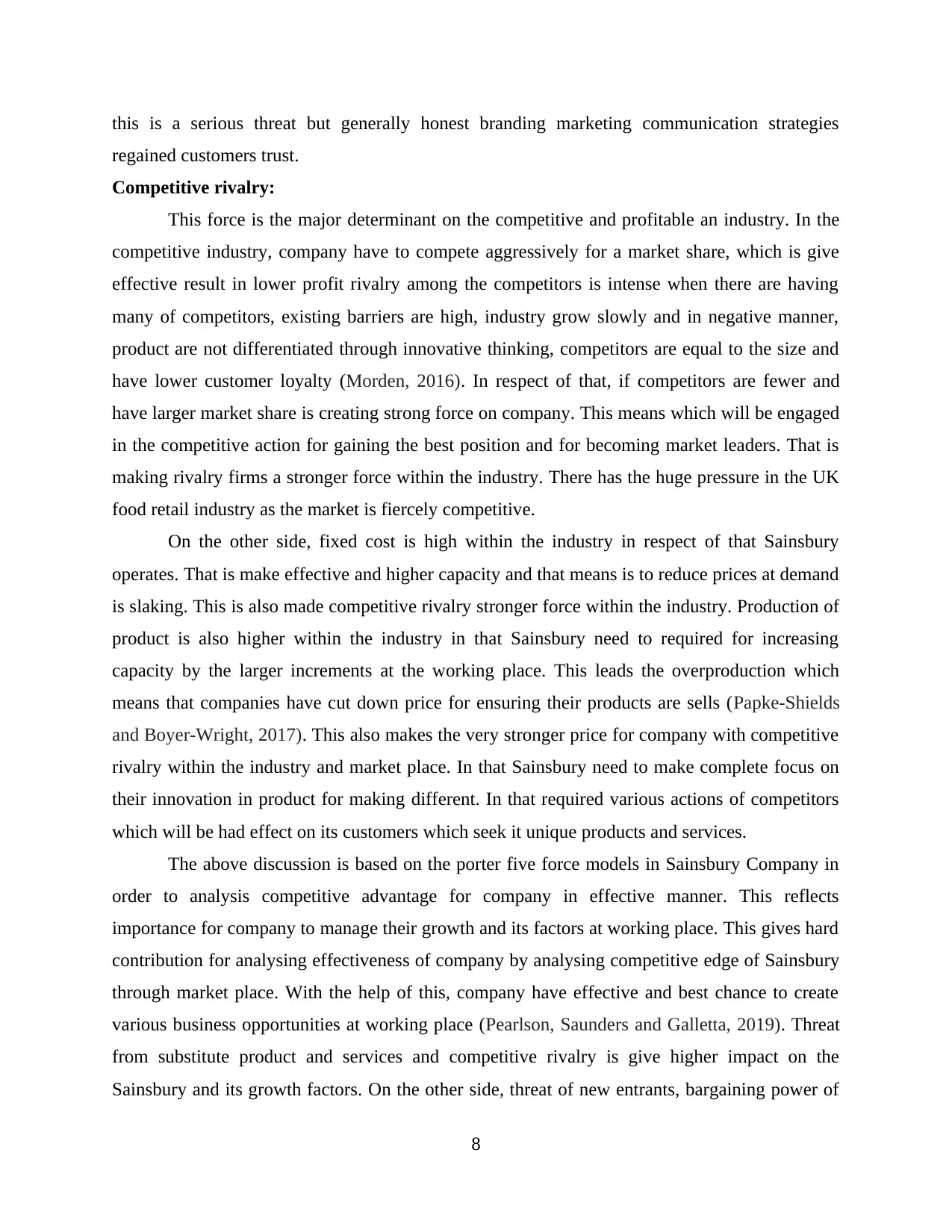
this is a serious threat but generally honest branding marketing communication strategies
regained customers trust.
Competitive rivalry:
This force is the major determinant on the competitive and profitable an industry. In the
competitive industry, company have to compete aggressively for a market share, which is give
effective result in lower profit rivalry among the competitors is intense when there are having
many of competitors, existing barriers are high, industry grow slowly and in negative manner,
product are not differentiated through innovative thinking, competitors are equal to the size and
have lower customer loyalty (Morden, 2016). In respect of that, if competitors are fewer and
have larger market share is creating strong force on company. This means which will be engaged
in the competitive action for gaining the best position and for becoming market leaders. That is
making rivalry firms a stronger force within the industry. There has the huge pressure in the UK
food retail industry as the market is fiercely competitive.
On the other side, fixed cost is high within the industry in respect of that Sainsbury
operates. That is make effective and higher capacity and that means is to reduce prices at demand
is slaking. This is also made competitive rivalry stronger force within the industry. Production of
product is also higher within the industry in that Sainsbury need to required for increasing
capacity by the larger increments at the working place. This leads the overproduction which
means that companies have cut down price for ensuring their products are sells (Papke-Shields
and Boyer-Wright, 2017). This also makes the very stronger price for company with competitive
rivalry within the industry and market place. In that Sainsbury need to make complete focus on
their innovation in product for making different. In that required various actions of competitors
which will be had effect on its customers which seek it unique products and services.
The above discussion is based on the porter five force models in Sainsbury Company in
order to analysis competitive advantage for company in effective manner. This reflects
importance for company to manage their growth and its factors at working place. This gives hard
contribution for analysing effectiveness of company by analysing competitive edge of Sainsbury
through market place. With the help of this, company have effective and best chance to create
various business opportunities at working place (Pearlson, Saunders and Galletta, 2019). Threat
from substitute product and services and competitive rivalry is give higher impact on the
Sainsbury and its growth factors. On the other side, threat of new entrants, bargaining power of
8
regained customers trust.
Competitive rivalry:
This force is the major determinant on the competitive and profitable an industry. In the
competitive industry, company have to compete aggressively for a market share, which is give
effective result in lower profit rivalry among the competitors is intense when there are having
many of competitors, existing barriers are high, industry grow slowly and in negative manner,
product are not differentiated through innovative thinking, competitors are equal to the size and
have lower customer loyalty (Morden, 2016). In respect of that, if competitors are fewer and
have larger market share is creating strong force on company. This means which will be engaged
in the competitive action for gaining the best position and for becoming market leaders. That is
making rivalry firms a stronger force within the industry. There has the huge pressure in the UK
food retail industry as the market is fiercely competitive.
On the other side, fixed cost is high within the industry in respect of that Sainsbury
operates. That is make effective and higher capacity and that means is to reduce prices at demand
is slaking. This is also made competitive rivalry stronger force within the industry. Production of
product is also higher within the industry in that Sainsbury need to required for increasing
capacity by the larger increments at the working place. This leads the overproduction which
means that companies have cut down price for ensuring their products are sells (Papke-Shields
and Boyer-Wright, 2017). This also makes the very stronger price for company with competitive
rivalry within the industry and market place. In that Sainsbury need to make complete focus on
their innovation in product for making different. In that required various actions of competitors
which will be had effect on its customers which seek it unique products and services.
The above discussion is based on the porter five force models in Sainsbury Company in
order to analysis competitive advantage for company in effective manner. This reflects
importance for company to manage their growth and its factors at working place. This gives hard
contribution for analysing effectiveness of company by analysing competitive edge of Sainsbury
through market place. With the help of this, company have effective and best chance to create
various business opportunities at working place (Pearlson, Saunders and Galletta, 2019). Threat
from substitute product and services and competitive rivalry is give higher impact on the
Sainsbury and its growth factors. On the other side, threat of new entrants, bargaining power of
8
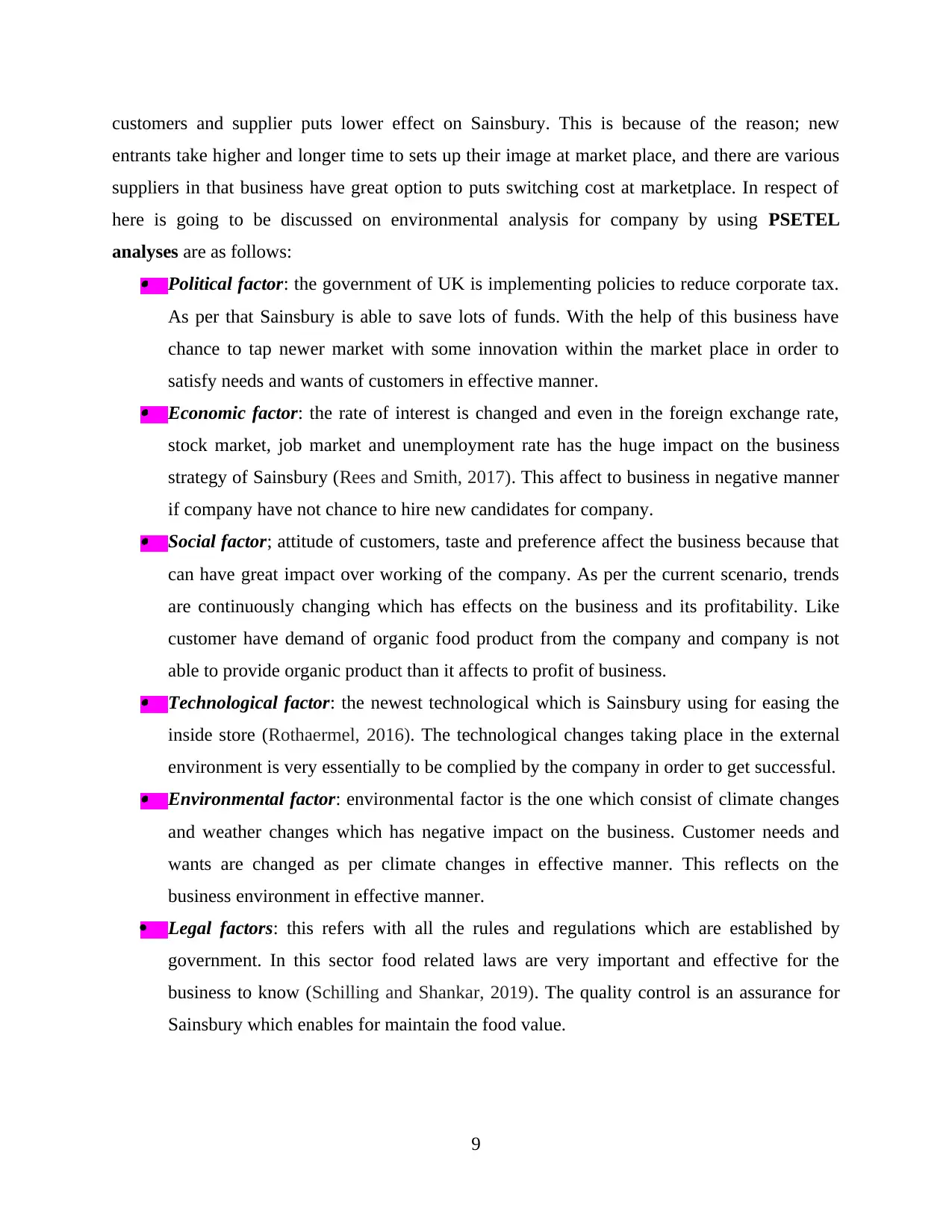
customers and supplier puts lower effect on Sainsbury. This is because of the reason; new
entrants take higher and longer time to sets up their image at market place, and there are various
suppliers in that business have great option to puts switching cost at marketplace. In respect of
here is going to be discussed on environmental analysis for company by using PSETEL
analyses are as follows: Political factor: the government of UK is implementing policies to reduce corporate tax.
As per that Sainsbury is able to save lots of funds. With the help of this business have
chance to tap newer market with some innovation within the market place in order to
satisfy needs and wants of customers in effective manner. Economic factor: the rate of interest is changed and even in the foreign exchange rate,
stock market, job market and unemployment rate has the huge impact on the business
strategy of Sainsbury (Rees and Smith, 2017). This affect to business in negative manner
if company have not chance to hire new candidates for company. Social factor; attitude of customers, taste and preference affect the business because that
can have great impact over working of the company. As per the current scenario, trends
are continuously changing which has effects on the business and its profitability. Like
customer have demand of organic food product from the company and company is not
able to provide organic product than it affects to profit of business. Technological factor: the newest technological which is Sainsbury using for easing the
inside store (Rothaermel, 2016). The technological changes taking place in the external
environment is very essentially to be complied by the company in order to get successful. Environmental factor: environmental factor is the one which consist of climate changes
and weather changes which has negative impact on the business. Customer needs and
wants are changed as per climate changes in effective manner. This reflects on the
business environment in effective manner.
Legal factors: this refers with all the rules and regulations which are established by
government. In this sector food related laws are very important and effective for the
business to know (Schilling and Shankar, 2019). The quality control is an assurance for
Sainsbury which enables for maintain the food value.
9
entrants take higher and longer time to sets up their image at market place, and there are various
suppliers in that business have great option to puts switching cost at marketplace. In respect of
here is going to be discussed on environmental analysis for company by using PSETEL
analyses are as follows: Political factor: the government of UK is implementing policies to reduce corporate tax.
As per that Sainsbury is able to save lots of funds. With the help of this business have
chance to tap newer market with some innovation within the market place in order to
satisfy needs and wants of customers in effective manner. Economic factor: the rate of interest is changed and even in the foreign exchange rate,
stock market, job market and unemployment rate has the huge impact on the business
strategy of Sainsbury (Rees and Smith, 2017). This affect to business in negative manner
if company have not chance to hire new candidates for company. Social factor; attitude of customers, taste and preference affect the business because that
can have great impact over working of the company. As per the current scenario, trends
are continuously changing which has effects on the business and its profitability. Like
customer have demand of organic food product from the company and company is not
able to provide organic product than it affects to profit of business. Technological factor: the newest technological which is Sainsbury using for easing the
inside store (Rothaermel, 2016). The technological changes taking place in the external
environment is very essentially to be complied by the company in order to get successful. Environmental factor: environmental factor is the one which consist of climate changes
and weather changes which has negative impact on the business. Customer needs and
wants are changed as per climate changes in effective manner. This reflects on the
business environment in effective manner.
Legal factors: this refers with all the rules and regulations which are established by
government. In this sector food related laws are very important and effective for the
business to know (Schilling and Shankar, 2019). The quality control is an assurance for
Sainsbury which enables for maintain the food value.
9
⊘ This is a preview!⊘
Do you want full access?
Subscribe today to unlock all pages.

Trusted by 1+ million students worldwide
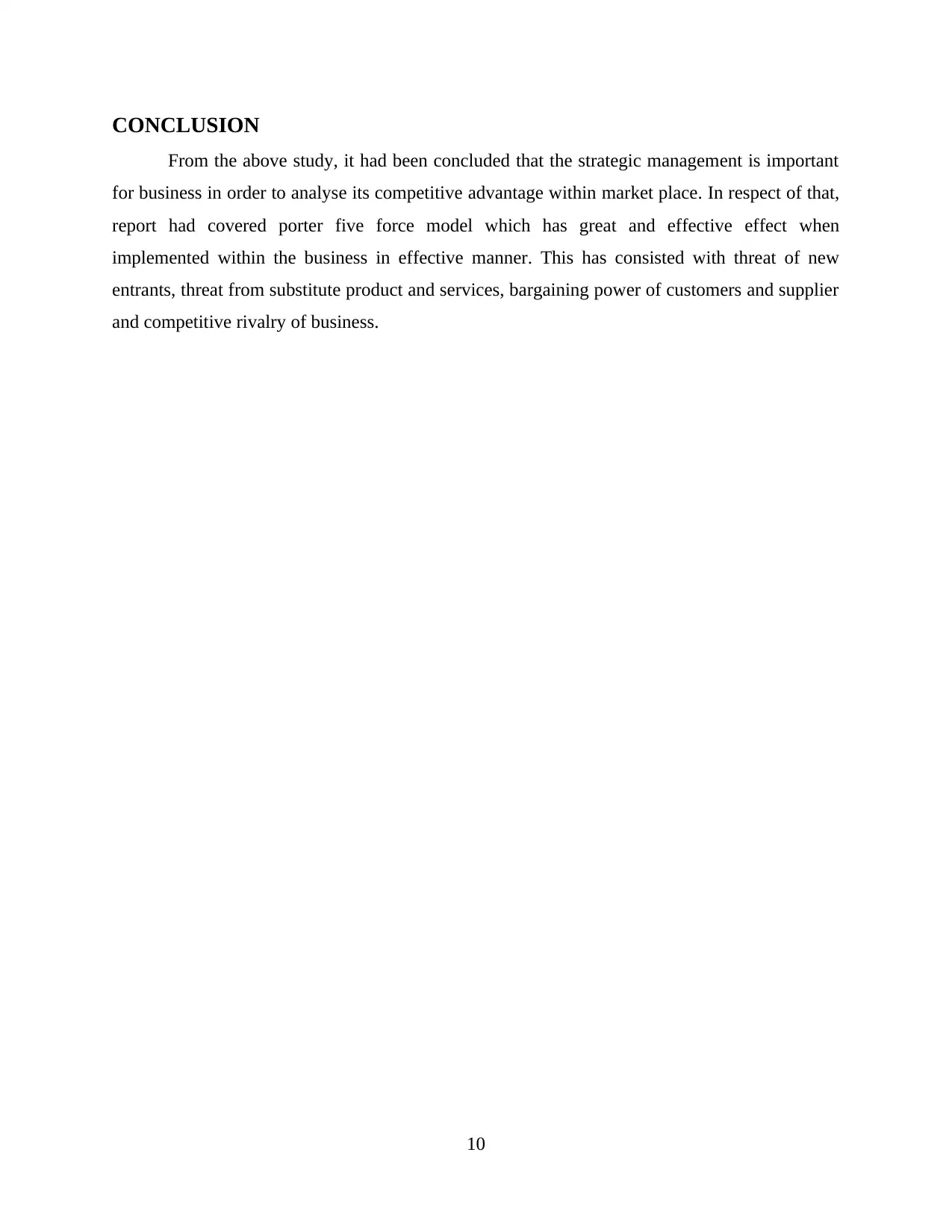
CONCLUSION
From the above study, it had been concluded that the strategic management is important
for business in order to analyse its competitive advantage within market place. In respect of that,
report had covered porter five force model which has great and effective effect when
implemented within the business in effective manner. This has consisted with threat of new
entrants, threat from substitute product and services, bargaining power of customers and supplier
and competitive rivalry of business.
10
From the above study, it had been concluded that the strategic management is important
for business in order to analyse its competitive advantage within market place. In respect of that,
report had covered porter five force model which has great and effective effect when
implemented within the business in effective manner. This has consisted with threat of new
entrants, threat from substitute product and services, bargaining power of customers and supplier
and competitive rivalry of business.
10
Paraphrase This Document
Need a fresh take? Get an instant paraphrase of this document with our AI Paraphraser
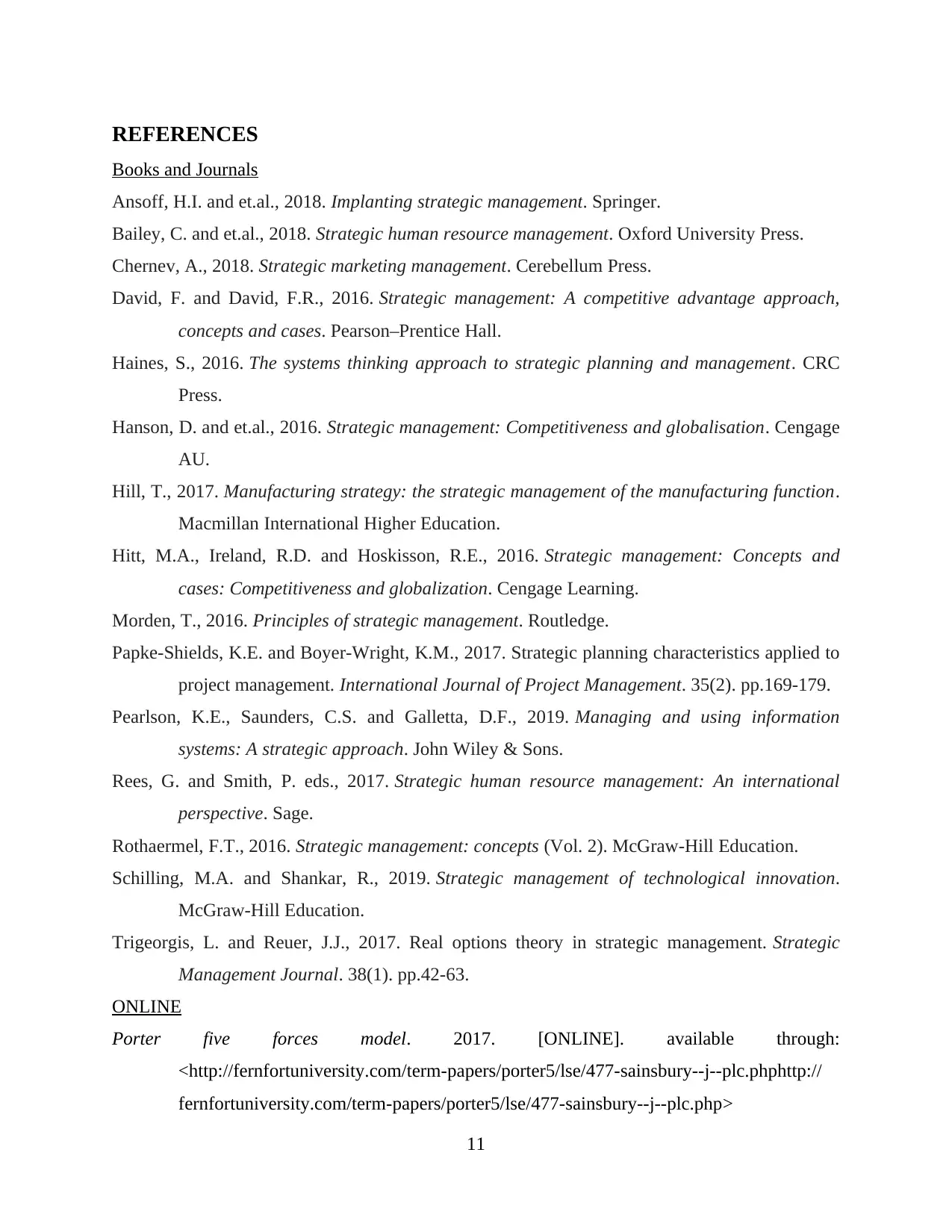
REFERENCES
Books and Journals
Ansoff, H.I. and et.al., 2018. Implanting strategic management. Springer.
Bailey, C. and et.al., 2018. Strategic human resource management. Oxford University Press.
Chernev, A., 2018. Strategic marketing management. Cerebellum Press.
David, F. and David, F.R., 2016. Strategic management: A competitive advantage approach,
concepts and cases. Pearson–Prentice Hall.
Haines, S., 2016. The systems thinking approach to strategic planning and management. CRC
Press.
Hanson, D. and et.al., 2016. Strategic management: Competitiveness and globalisation. Cengage
AU.
Hill, T., 2017. Manufacturing strategy: the strategic management of the manufacturing function.
Macmillan International Higher Education.
Hitt, M.A., Ireland, R.D. and Hoskisson, R.E., 2016. Strategic management: Concepts and
cases: Competitiveness and globalization. Cengage Learning.
Morden, T., 2016. Principles of strategic management. Routledge.
Papke-Shields, K.E. and Boyer-Wright, K.M., 2017. Strategic planning characteristics applied to
project management. International Journal of Project Management. 35(2). pp.169-179.
Pearlson, K.E., Saunders, C.S. and Galletta, D.F., 2019. Managing and using information
systems: A strategic approach. John Wiley & Sons.
Rees, G. and Smith, P. eds., 2017. Strategic human resource management: An international
perspective. Sage.
Rothaermel, F.T., 2016. Strategic management: concepts (Vol. 2). McGraw-Hill Education.
Schilling, M.A. and Shankar, R., 2019. Strategic management of technological innovation.
McGraw-Hill Education.
Trigeorgis, L. and Reuer, J.J., 2017. Real options theory in strategic management. Strategic
Management Journal. 38(1). pp.42-63.
ONLINE
Porter five forces model. 2017. [ONLINE]. available through:
<http://fernfortuniversity.com/term-papers/porter5/lse/477-sainsbury--j--plc.phphttp://
fernfortuniversity.com/term-papers/porter5/lse/477-sainsbury--j--plc.php>
11
Books and Journals
Ansoff, H.I. and et.al., 2018. Implanting strategic management. Springer.
Bailey, C. and et.al., 2018. Strategic human resource management. Oxford University Press.
Chernev, A., 2018. Strategic marketing management. Cerebellum Press.
David, F. and David, F.R., 2016. Strategic management: A competitive advantage approach,
concepts and cases. Pearson–Prentice Hall.
Haines, S., 2016. The systems thinking approach to strategic planning and management. CRC
Press.
Hanson, D. and et.al., 2016. Strategic management: Competitiveness and globalisation. Cengage
AU.
Hill, T., 2017. Manufacturing strategy: the strategic management of the manufacturing function.
Macmillan International Higher Education.
Hitt, M.A., Ireland, R.D. and Hoskisson, R.E., 2016. Strategic management: Concepts and
cases: Competitiveness and globalization. Cengage Learning.
Morden, T., 2016. Principles of strategic management. Routledge.
Papke-Shields, K.E. and Boyer-Wright, K.M., 2017. Strategic planning characteristics applied to
project management. International Journal of Project Management. 35(2). pp.169-179.
Pearlson, K.E., Saunders, C.S. and Galletta, D.F., 2019. Managing and using information
systems: A strategic approach. John Wiley & Sons.
Rees, G. and Smith, P. eds., 2017. Strategic human resource management: An international
perspective. Sage.
Rothaermel, F.T., 2016. Strategic management: concepts (Vol. 2). McGraw-Hill Education.
Schilling, M.A. and Shankar, R., 2019. Strategic management of technological innovation.
McGraw-Hill Education.
Trigeorgis, L. and Reuer, J.J., 2017. Real options theory in strategic management. Strategic
Management Journal. 38(1). pp.42-63.
ONLINE
Porter five forces model. 2017. [ONLINE]. available through:
<http://fernfortuniversity.com/term-papers/porter5/lse/477-sainsbury--j--plc.phphttp://
fernfortuniversity.com/term-papers/porter5/lse/477-sainsbury--j--plc.php>
11

12
⊘ This is a preview!⊘
Do you want full access?
Subscribe today to unlock all pages.

Trusted by 1+ million students worldwide
1 out of 12
Related Documents
Your All-in-One AI-Powered Toolkit for Academic Success.
+13062052269
info@desklib.com
Available 24*7 on WhatsApp / Email
![[object Object]](/_next/static/media/star-bottom.7253800d.svg)
Unlock your academic potential
Copyright © 2020–2025 A2Z Services. All Rights Reserved. Developed and managed by ZUCOL.





